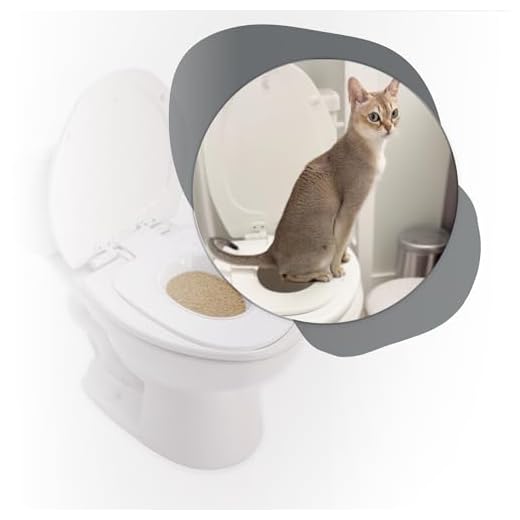



It’s possible to guide your furry companion to relieve themselves in the great outdoors. Begin by understanding their natural instincts and comfort levels. Start with incremental steps to ease them into this routine.
First, introduce a designated spot outside that feels safe and inviting. Cats are creatures of habit, so consistency is key. Use treats and positive reinforcement to encourage them to explore this new area.
Next, gradually transition from a litter box to this outdoor location. Place the litter box near the exit to the outdoors and slowly move it closer to the chosen spot. Over time, reduce the amount of litter to help them adapt to the new environment.
Be patient and observant. Every feline is unique, and some may take longer to adjust than others. Monitor their behavior and ensure they feel secure. With the right approach, your pet can enjoy the fresh air while taking care of their needs.
Step-by-step guide to outdoor toilet training for felines
First, select a suitable spot in your yard that is quiet and away from heavy foot traffic. This location should be easily accessible and comfortable for your furry friend.
Next, introduce a litter box outdoors, placing it in the chosen area. Use the same type of litter that your pet is accustomed to, which can help ease the transition.
Gradually, move the litter box closer to the door over several days. Each time, shift it a few feet toward the exit until it reaches the designated outdoor location. This method familiarizes your companion with the new routine.
Once the litter box is in the final spot, reduce the amount of litter over time. This can encourage the transition to a more natural surface. Observe your pet closely during this phase to ensure comfort.
After a week or so, eliminate the litter completely. Allow your furry friend to explore the area without any barriers. Encourage exploration using treats or toys to create a positive association with the outdoor space.
Monitor behaviors and reactions. If your pet shows reluctance, consider reverting to the litter box temporarily before continuing the process. Patience is key during this adjustment.
Throughout this process, ensure your feline companion is well-fed with appropriate nutrition. For those with specific health needs, like kidney stones, be mindful to offer best food for cats with kidney stones to support their wellbeing.
Lastly, maintain consistency and provide positive reinforcement. Celebrate successes, no matter how small, to foster confidence in this new habit.
Common challenges and solutions in training felines for outdoor restroom habits
One major hurdle I face is my human’s concern about safety. Outdoor spaces can be unpredictable, with potential dangers like cars or aggressive animals. It’s crucial to supervise my explorations closely and choose a secure area for my outdoor activities. A fenced garden or a leash can provide a safer environment.
Another challenge is getting accustomed to new smells and surfaces. Some of my fellow felines may feel hesitant to adapt. Gradual exposure helps; introducing me to various outdoor spots slowly allows me to become familiar with the environment. Treats and positive reinforcement work wonders in creating a sense of comfort.
Weather conditions
Rainy or cold days can deter me from venturing outside. It’s essential to establish a routine that accommodates changing weather. On inclement days, I appreciate shorter outdoor sessions or exploring sheltered areas. Providing a cozy spot outside, like a covered platform, can make outdoor time more inviting.
Consistency in routines
Inconsistency can lead to confusion. My human should maintain a regular schedule for my outdoor visits. This helps me to understand when to expect my outdoor adventures, making it easier to adjust my habits. Consistent cues, like specific phrases or sounds, signal that it’s time to step outside.
It’s possible to guide your furry companion to relieve themselves in the great outdoors. Begin by understanding their natural instincts and comfort levels. Start with incremental steps to ease them into this routine.
First, introduce a designated spot outside that feels safe and inviting. Cats are creatures of habit, so consistency is key. Use treats and positive reinforcement to encourage them to explore this new area.
Next, gradually transition from a litter box to this outdoor location. Place the litter box near the exit to the outdoors and slowly move it closer to the chosen spot. Over time, reduce the amount of litter to help them adapt to the new environment.
Be patient and observant. Every feline is unique, and some may take longer to adjust than others. Monitor their behavior and ensure they feel secure. With the right approach, your pet can enjoy the fresh air while taking care of their needs.
Step-by-step guide to outdoor toilet training for felines
First, select a suitable spot in your yard that is quiet and away from heavy foot traffic. This location should be easily accessible and comfortable for your furry friend.
Next, introduce a litter box outdoors, placing it in the chosen area. Use the same type of litter that your pet is accustomed to, which can help ease the transition.
Gradually, move the litter box closer to the door over several days. Each time, shift it a few feet toward the exit until it reaches the designated outdoor location. This method familiarizes your companion with the new routine.
Once the litter box is in the final spot, reduce the amount of litter over time. This can encourage the transition to a more natural surface. Observe your pet closely during this phase to ensure comfort.
After a week or so, eliminate the litter completely. Allow your furry friend to explore the area without any barriers. Encourage exploration using treats or toys to create a positive association with the outdoor space.
Monitor behaviors and reactions. If your pet shows reluctance, consider reverting to the litter box temporarily before continuing the process. Patience is key during this adjustment.
Throughout this process, ensure your feline companion is well-fed with appropriate nutrition. For those with specific health needs, like kidney stones, be mindful to offer best food for cats with kidney stones to support their wellbeing.
Lastly, maintain consistency and provide positive reinforcement. Celebrate successes, no matter how small, to foster confidence in this new habit.
Common challenges and solutions in training felines for outdoor restroom habits
One major hurdle I face is my human’s concern about safety. Outdoor spaces can be unpredictable, with potential dangers like cars or aggressive animals. It’s crucial to supervise my explorations closely and choose a secure area for my outdoor activities. A fenced garden or a leash can provide a safer environment.
Another challenge is getting accustomed to new smells and surfaces. Some of my fellow felines may feel hesitant to adapt. Gradual exposure helps; introducing me to various outdoor spots slowly allows me to become familiar with the environment. Treats and positive reinforcement work wonders in creating a sense of comfort.
Weather conditions
Rainy or cold days can deter me from venturing outside. It’s essential to establish a routine that accommodates changing weather. On inclement days, I appreciate shorter outdoor sessions or exploring sheltered areas. Providing a cozy spot outside, like a covered platform, can make outdoor time more inviting.
Consistency in routines
Inconsistency can lead to confusion. My human should maintain a regular schedule for my outdoor visits. This helps me to understand when to expect my outdoor adventures, making it easier to adjust my habits. Consistent cues, like specific phrases or sounds, signal that it’s time to step outside.
It’s possible to guide your furry companion to relieve themselves in the great outdoors. Begin by understanding their natural instincts and comfort levels. Start with incremental steps to ease them into this routine.
First, introduce a designated spot outside that feels safe and inviting. Cats are creatures of habit, so consistency is key. Use treats and positive reinforcement to encourage them to explore this new area.
Next, gradually transition from a litter box to this outdoor location. Place the litter box near the exit to the outdoors and slowly move it closer to the chosen spot. Over time, reduce the amount of litter to help them adapt to the new environment.
Be patient and observant. Every feline is unique, and some may take longer to adjust than others. Monitor their behavior and ensure they feel secure. With the right approach, your pet can enjoy the fresh air while taking care of their needs.
Step-by-step guide to outdoor toilet training for felines
First, select a suitable spot in your yard that is quiet and away from heavy foot traffic. This location should be easily accessible and comfortable for your furry friend.
Next, introduce a litter box outdoors, placing it in the chosen area. Use the same type of litter that your pet is accustomed to, which can help ease the transition.
Gradually, move the litter box closer to the door over several days. Each time, shift it a few feet toward the exit until it reaches the designated outdoor location. This method familiarizes your companion with the new routine.
Once the litter box is in the final spot, reduce the amount of litter over time. This can encourage the transition to a more natural surface. Observe your pet closely during this phase to ensure comfort.
After a week or so, eliminate the litter completely. Allow your furry friend to explore the area without any barriers. Encourage exploration using treats or toys to create a positive association with the outdoor space.
Monitor behaviors and reactions. If your pet shows reluctance, consider reverting to the litter box temporarily before continuing the process. Patience is key during this adjustment.
Throughout this process, ensure your feline companion is well-fed with appropriate nutrition. For those with specific health needs, like kidney stones, be mindful to offer best food for cats with kidney stones to support their wellbeing.
Lastly, maintain consistency and provide positive reinforcement. Celebrate successes, no matter how small, to foster confidence in this new habit.
Common challenges and solutions in training felines for outdoor restroom habits
One major hurdle I face is my human’s concern about safety. Outdoor spaces can be unpredictable, with potential dangers like cars or aggressive animals. It’s crucial to supervise my explorations closely and choose a secure area for my outdoor activities. A fenced garden or a leash can provide a safer environment.
Another challenge is getting accustomed to new smells and surfaces. Some of my fellow felines may feel hesitant to adapt. Gradual exposure helps; introducing me to various outdoor spots slowly allows me to become familiar with the environment. Treats and positive reinforcement work wonders in creating a sense of comfort.
Weather conditions
Rainy or cold days can deter me from venturing outside. It’s essential to establish a routine that accommodates changing weather. On inclement days, I appreciate shorter outdoor sessions or exploring sheltered areas. Providing a cozy spot outside, like a covered platform, can make outdoor time more inviting.
Consistency in routines
Inconsistency can lead to confusion. My human should maintain a regular schedule for my outdoor visits. This helps me to understand when to expect my outdoor adventures, making it easier to adjust my habits. Consistent cues, like specific phrases or sounds, signal that it’s time to step outside.









